The first graders visited the lab yesterday to listen to book talks from their third grade reading buddies. The third graders had posted their videos to their blogs. (Click here to read about the process of making the videos.)
The students logged into their KidBlog account, clicked on the third grade blog link, then found their buddy. They were to listen to the book talk then leave a comment. I won’t say the process went smoothly – I guess when you try to watch 22 videos at one time, things won’t proceed without hiccups. But we survived and all first graders were able to hear at least one book talk and leave a comment for their buddies.
Prior to turning them loose, we discussed what they could say after listening to the video. I introduced the terms “penny” and “dollar” comments and we brainstormed examples of each. (Penny comments are not worth much; they don’t provide good information to the author. Dollar comments give details, compliments, share information.) The students had some very sweet comments – it was obvious that they adore their older buddies!
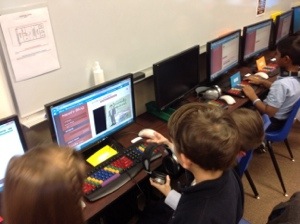
Besides connecting with their reading buddies in class, blogging is a fabulous way for students to share with each other!
This is not my original idea but it is a powerful way to review the blogging process!
The following resources introduced me to paper blogging.
What always amazes me is how involved the students become with paper blogging! Not one person asks about getting on the computers! Our students have blogged since first grade but I always like to include this activity – just to make sure students refocus on the intent of our blogs: To share their learning in a positive and meaningful way.
Taking the food idea from Leonard Low’s Workshop Activity: Paper Blogs, I asked students to raise their hand if they liked to eat. Of course, that brought an enthusiastic response! I told them that they would be writing a blog post on paper and the following day would be spent writing comments using sticky notes.
The instructions were to write about a favorite food – it could be from a restaurant or something made by parents, relatives, or anyone else. They needed to write something that would paint a picture for the reader – use details! Pictures always spruce up a post so illustrations were strongly encouraged.
The paper was distributed and we worked together to include the basics of a post:
- First name at the top (good place to talk about keeping personal information private; no last names)
- Tags – This was a good review for students. What is your post about? Everyone could add “food” as a tag. As you write, you’ll think of other tags to add that would help readers find all posts about specific subjects . . .
- Title – every post needs a title!
Then the students scattered in the small room to find a space to write. At first there were murmurings about their topic and how delicious their chosen food was (and how hungry they were becoming just thinking about it . . .), but soon all you could hear were pencils and pens scratching across the paper.
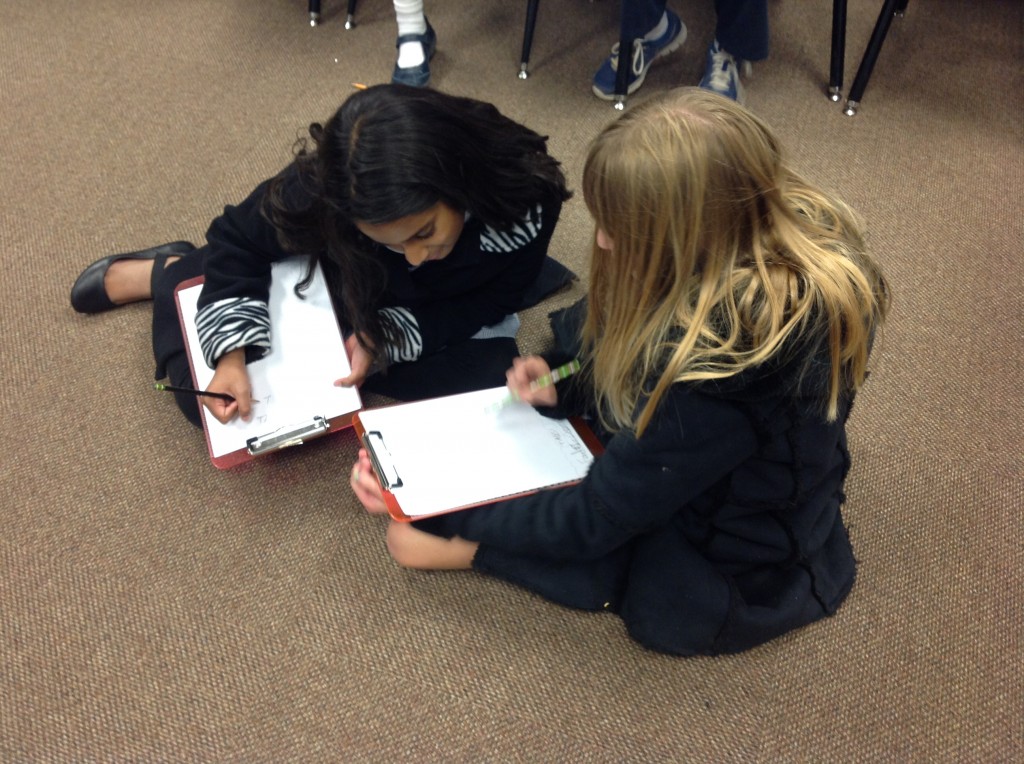 The next day, students came in to find four sticky notes on top of their post. We discussed penny comments versus dollar (and up) comments. There were some puzzled looks when I mentioned a penny comment but I asked how much they could buy with a penny. “Nothing” was the general consensus. We compared that to a “nothing” comment – a word or two that didn’t add anything to the conversation. But a dollar comment would include details, ask questions, make connections. Of course, the competitive nature of children meant that each wanted to beat a dollar comment – $5, $10, and up were certainly better than just $1!
The next day, students came in to find four sticky notes on top of their post. We discussed penny comments versus dollar (and up) comments. There were some puzzled looks when I mentioned a penny comment but I asked how much they could buy with a penny. “Nothing” was the general consensus. We compared that to a “nothing” comment – a word or two that didn’t add anything to the conversation. But a dollar comment would include details, ask questions, make connections. Of course, the competitive nature of children meant that each wanted to beat a dollar comment – $5, $10, and up were certainly better than just $1!
I had the students stand at their seats with a pencil in hand. Instructions were to read the post and write a comment, including their first name. I had them count four chairs clockwise. At that point they stopped, read the post and wrote a comment. When finished we repeated the process. This time they could comment on the blog OR respond to the comment. We did this a total of four times, going clockwise or counter-clockwise (just to keep everyone guessing!).
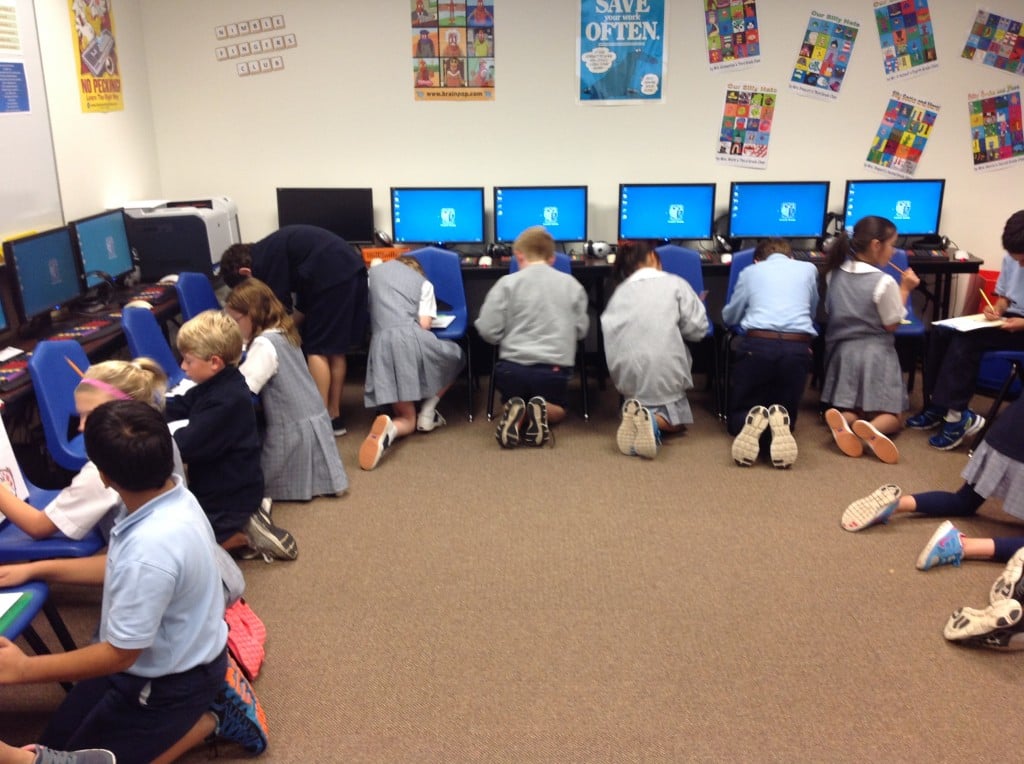
 After the last round, the students returned to their seats to read their comments. We then discussed the following, sharing examples:
After the last round, the students returned to their seats to read their comments. We then discussed the following, sharing examples:
- Anonymous comments – it was decided that we prefer to know who the writer is
- Irrelevant comments – those that had nothing to do with the post
- Penny comments – Students offered to read what they thought were penny comments without giving the author. The funny thing was that, even though the reader gave no clues as to who the author was, the student in question generally confessed, “That was me. I know I should have written more.” (Yea! They are getting it!)
- Dollar comments – Lots of hands went up to share. We really had some strong, quality comments – possibly because the children wanted to impress each other.
I had one student who, shall we say, is not always into the lessons. He surprised me by writing some amazing comments and was always the one we were waiting on to finish the comments! When we debriefed, his name came up several times when we shared the dollar comments.
I can’t wait to read their online blogs!
Did you know that November is Picture Book Month? Mrs. Murphy and Mrs. Hebert, our librarians, issued a challenge to the Lower School to read picture books in an effort to beat last year’s goal of 4,370.
For the past several weeks, we’ve been discussing blogging when the students come to the lab. To correlate with blogging and the library’s challenge, I asked the third graders to bring a picture book to the lab. They were to produce a book talk and upload it to their blog.
We started class by taking a picture of their book cover.
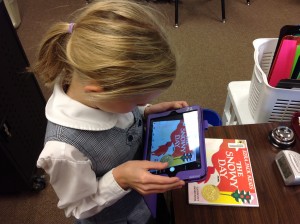
The next step was to read the book.
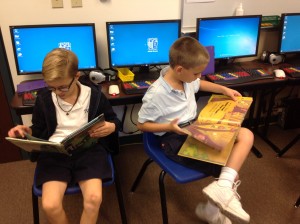 Writing isn’t always a favored part of a third grader’s life but the students did understand that this step is important to organizing thoughts and really makes the recording go much more smoothly.
Writing isn’t always a favored part of a third grader’s life but the students did understand that this step is important to organizing thoughts and really makes the recording go much more smoothly.
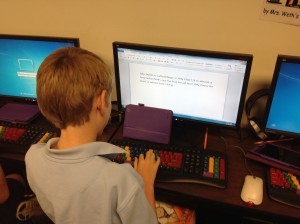 The next step was to choose an app. I gave the option of Tellagami (free; available on App Store and Google Play) and ChatterPix Kids (free from App Store). Both have a limit of 30 seconds so students needed to be concise in what they said. Both also allow the user to import photos from the camera roll. With Tellagami, the students created an avatar that “spoke” their recorded message. With ChatterPix, a “mouth” line is drawn and that moves to the narration. The students enjoyed creating a mouth on their book cover.
The next step was to choose an app. I gave the option of Tellagami (free; available on App Store and Google Play) and ChatterPix Kids (free from App Store). Both have a limit of 30 seconds so students needed to be concise in what they said. Both also allow the user to import photos from the camera roll. With Tellagami, the students created an avatar that “spoke” their recorded message. With ChatterPix, a “mouth” line is drawn and that moves to the narration. The students enjoyed creating a mouth on their book cover.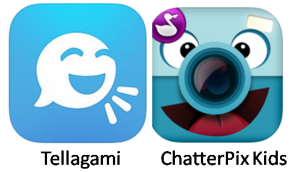 The students recorded, made sure they were satisfied with the sound, saved to photos, then emailed the video to me. Once students completed the process, I put them to work helping others.
The students recorded, made sure they were satisfied with the sound, saved to photos, then emailed the video to me. Once students completed the process, I put them to work helping others.

Finally, the children uploaded their video to the KidBlog app. Next week their first grade buddies will be listening to the book talks and making comments on their buddies’ posts. I also posted all the book talks on TVS TechnoWizards.
Class Blogs:
Below is a visual of the apps we used for the project.

What is Gump Day? Another name for Halloween! Years ago, we had a teacher at TVS who loved to dress up. Our Halloween celebration was named after her and the Gump Day tradition began. It is a BIG deal at our school with teachers and students alike dressing up. (There is fierce competition amongst teachers in the costume contest!)
Here is a glimpse of our celebration:










